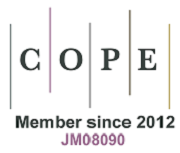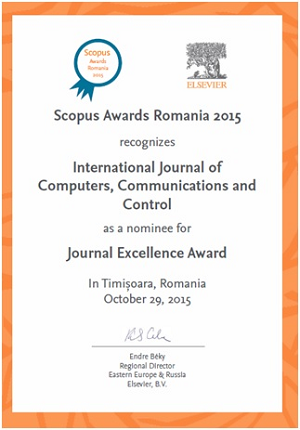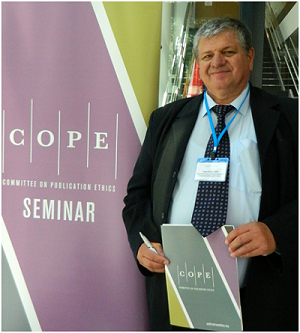Delay/Disruption Tolerant Networking-Based Routing for Rural Internet Connectivity (DRINC)
Keywords:
dtn routing, opportunistic forwarding, rural connectivity, rural internet, non-real-time communicationsAbstract
Rural networking connectivity is a very dynamic and attractive research field. Nowadays big IT companies and many governments are working to help connect all these rural, disconnected people to Internet. This paper introduces a new routing algorithm that can bring non-real-time Internet connectivity to rural users. This solution is based on previously tested ideas, especially on Delay/Disruption Tolerant Networking technologies, since they can be used to transmit messages to and from difficult to access sites. It introduces the rural connectivity problem and its context. Then, it shows the proposed solution with its mathematical model used to describe the problem, its proposed heuristic, and its results. The advantage of our solution is that it is a low-cost technology that uses locally available infrastructure to reach even the most remote towns. The mathematical model describes the problem of transmitting messages from a rural, usually disconnected user, to an Internet connected node, through a non-reliable network using estimated delivery probabilities varying through time. The forwarding algorithm uses local knowledge gathered from interactions with other nodes, and it learns which nodes are more likely to connect in the future, and which nodes are more likely to deliver the messages to the destination. Our algorithm achieves an equal or better performance in delivery rate and delay than other well-known routing protocols for the rural scenarios tested. This paper adds more simulation results for the proposed rural scenarios, and it also extends the explanation of the mathematical model and the heuristic algorithm from the conference paper "Delay/Disruption Tolerant Networks Based Message Forwarding Algorithm for Rural Internet Connectivity Applications" [1] (doi: 10.1109/ICCCC. 2016.7496732).References
Velásquez-Villada, C.; Donoso, Y. (2016); Delay/Disruption Tolerant Networks Based Message Forwarding Algorithm for Rural Internet Connectivity Applications, Computers Communications and Control (ICCCC), 2016 6th International Conference on, IEEE Xplore, e-ISSN 978-1-5090-1735-5, doi: 10.1109/ICCCC.2016.7496732, 16-22. https://doi.org/10.1109/ICCCC.2016.7496732
La Rue, F. (2011); Report of the Special Rapporteur on the promotion and protection of the right to freedom of opinion and expression Special Procedures of the Human Rights Council, United Nations.
International Telecommunication Union. (2016); Measuring the Information Society. http://www.itu.int/en/ITUD/Statistics/Pages/stat/default.aspx
Velásquez-Villada, C.; Solano, F.; Donoso Y. (2015); Routing Optimization for Delay Tolerant Networks in Rural Applications Using a Distributed Algorithm. International Journal of Computers, Communications and Control. 10(1):100-111. https://doi.org/10.15837/ijccc.2015.1.1569
Cerf, V. et al. (2007); RFC4838-Delay-Tolerant Networking Architecture. IETF RFC 4838.
Pentland, A. S.; Fletcher, R.; Hasson, A. (2004); Daknet: Rethinking connectivity in developing nations. Computer, 37(1):78-83. https://doi.org/10.1109/MC.2004.1260729
Lindgren, A. et al. (2012); Probabilistic routing protocol for intermittently connected networks. Technical report, IETF RFC 6693, Experimental.
Keranen, A.; Ott, J.; Karkkainen T. (2009); The ONE simulator for DTN protocol evaluation, Proc. of the 2nd intl. conf. on simulation tools and techniques, ICST, art.55, 1-10.
Scott, K.; Burleigh, S. (2007); RFC5050: Bundle protocol specification. IETF RFC 5050.
Warthman, F. (2015); Delay and Disruption-Tolerant Networks (DTNs) A Tutorial. Based on Technology Developed by the DTN Research Group (DTN-RG), Version 3.2, 1-35.
Google Inc. (2016); Loon Project. https://www.google.com/loon/
Google Inc. (2016); Link Project. https://www.google.com/get/projectlink/
Facebook Inc. (2016); Internet.org. https://www.internet.org/projects
Choubey, N.; Panah, A. Y. (2016); Introducing Facebook's new terrestrial connectivity systems Terragraph and Project ARIES.
Ministerio de TecnologÃas de la Información y las Comunicaciones, Gobierno de Colombia. (2011); Proyecto Nacional de Fibra Óptica.
Watkins, J.; Tacchi, J.; Kiran, M.S. (2009); The role of intermediaries in the development of asynchronous rural access. In Universal Access in Human-Computer Interaction. Applications and Services, 451-459. Springer.
Vahdat, A.; Becker, D. (2000); Epidemic routing for partially connected ad hoc networks.
Spyropoulos, T.; Psounis, K.; Raghavendra, C. S. (2005); Spray and wait: an efficient routing scheme for intermittently connected mobile networks. Proceedings of the 2005 ACM SIGCOMM workshop on Delay-tolerant networking, 252-259. https://doi.org/10.1145/1080139.1080143
Khabbaz, M. J.; Assi, C. M.; Fawaz, W. F. (2012); Disruption-tolerant networking: A comprehensive survey on recent developments and persisting challenges. Communications Surveys & Tutorials, IEEE, 14(2):607-640. https://doi.org/10.1109/SURV.2011.041911.00093
Cao, Y.; Sun, Z. (2013); Routing in delay/disruption tolerant networks: A taxonomy, survey and challenges. Communications Surveys & Tutorials, IEEE, 15(2):654-677. https://doi.org/10.1109/SURV.2012.042512.00053
Psaras, I.; Wood, L.; Tafazolli, R. (2010); Delay-/disruption-tolerant networking: State of the art and future challenges. University of Surrey, Technical Report.
Velásquez-Villada C; Donoso Y. (2016); Delay/Disruption Tolerant Network-Based Message Forwarding for a River Pollution Monitoring Wireless Sensor Network Application. Sensors, 16:1-25. https://doi.org/10.3390/s16040436
OpenJUMP GIS (2016) http://www.openjump.org/
Published
Issue
Section
License
ONLINE OPEN ACCES: Acces to full text of each article and each issue are allowed for free in respect of Attribution-NonCommercial 4.0 International (CC BY-NC 4.0.
You are free to:
-Share: copy and redistribute the material in any medium or format;
-Adapt: remix, transform, and build upon the material.
The licensor cannot revoke these freedoms as long as you follow the license terms.
DISCLAIMER: The author(s) of each article appearing in International Journal of Computers Communications & Control is/are solely responsible for the content thereof; the publication of an article shall not constitute or be deemed to constitute any representation by the Editors or Agora University Press that the data presented therein are original, correct or sufficient to support the conclusions reached or that the experiment design or methodology is adequate.







